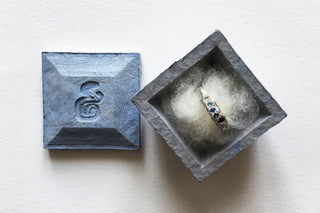Ines Gerard Cuesta is the founder of Ines & Litza
As I started making and selling jewellery, the question of sustainable packaging came pretty early. In my day-to-day life, I am an advocate of 'le meilleur déchet est celui que l’on ne produit pas', which is a French value that translates to 'the best waste is that which isn't produced'—it is better not to produce waste but to reuse it. This made it weird for me to buy something that I knew would become waste, just to adhere to the industry norms.
My first jewellery boxes were kraft boxes with a stamp on therm, cheap, fast and easy. They were recycled but the foam inside was synthetic, and very ugly. I tried to upgrade a bit, asked around for advice on sustainable packaging and only found big brands that offered what I considered as greenwashing options. All the truly sustainable packaging were too expensive for my young brand.
I considered offering wooden boxes, a nice option considering they could become cherished objects and not go to waste immediately after purchase. But again, it was a very expensive option, not yet suitable for my brand.
Then one day, I remembered that my first stockist, when I lived in Montreal, was developing stationary and objects made out of paper pulp, with a local paper maker. I also had a friend who moved to Indonesia to learn how to make paper and objects out of fresh bamboo pulp. If they could do it, so could I!
I first used an open-source mould design for a recycled cardboard box. Cardboard is a resource I am not lacking in my studio as everything I receive via post comes in a cardboard packaging, so why not repurpose it?
I 3D printed the mould and started experimenting with it, the boxes were sturdy but lacked finesse. They could be improved.
I am lucky enough to live with a talented designer to share ideas with and he designed the final box mould, with my logo embossed on the top.
The process is pretty straightforward :
- Shred the studio cardboard waste into small parts
- Mix it with water until homogenous
- Drop in a small amount of pigment
- Drain the water
- Press the pulp into a mould
- Let it dry
- De-mould the box and let it dry some more (a lot more!)
It takes about a week to completely dry.

The box making was a success but what of the foam? I could not safely send out my jewellery in a box without padding so I searched for sustainable alternatives.
This is when I came upon a website offering wool from local farms around my home. They explained that the wool from these farms was thrown away because it was unsuitable for the textile industry, and they were selling it by the kg to use it for mattress making or other purposes. I bought some and the wool is very soft and fluffy, perfect to secure the jewellery in the boxes.
The whole idea behind these jewellery boxes is to make a beautiful and useful object out of repurposed waste. I am still trying things out, and am sure I can still improve the impact of my brand on the environment. I am so happy to say I now make my jewellery AND my sustainable packaging by hand! These are important steps to build a brand that aligns with my values.


